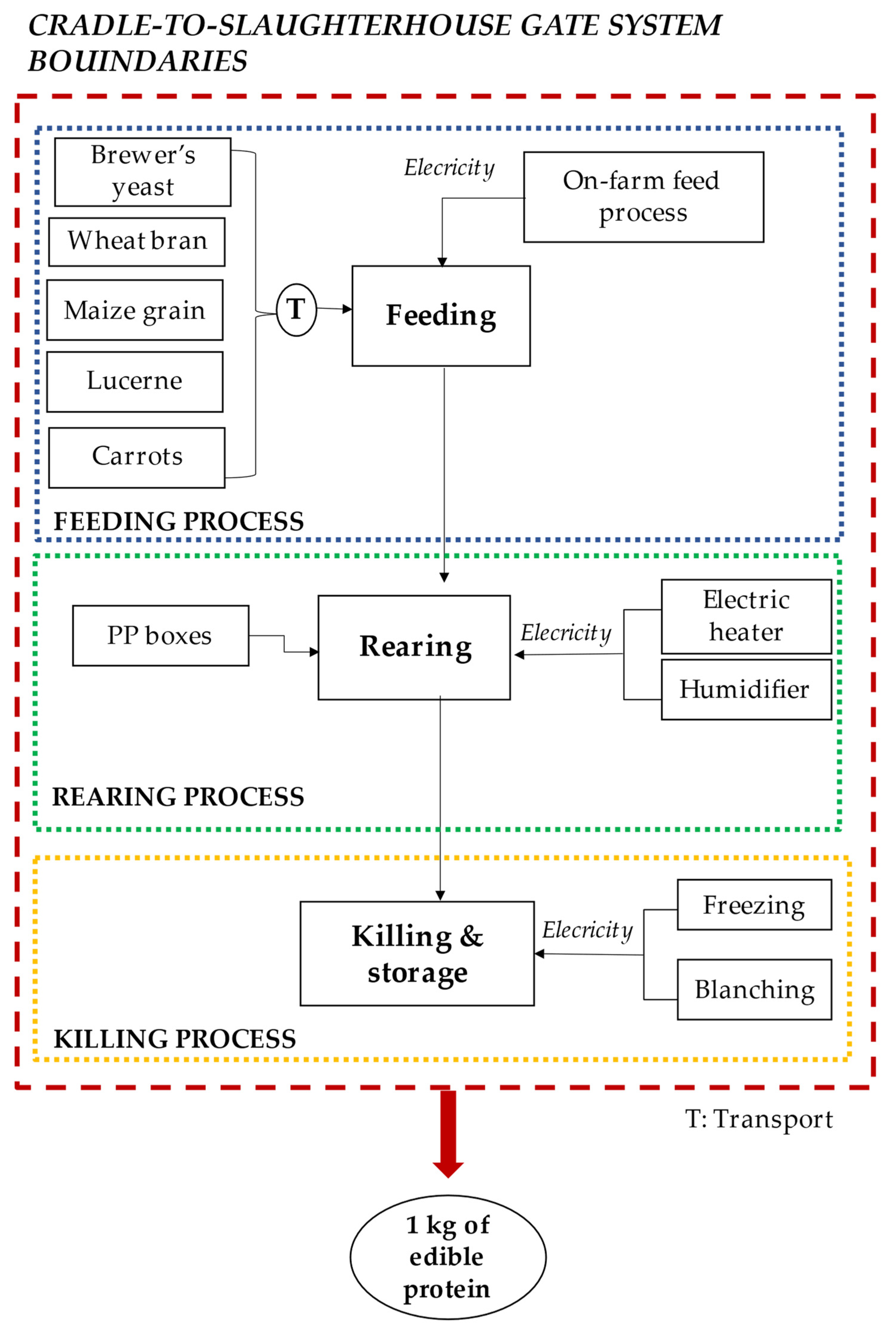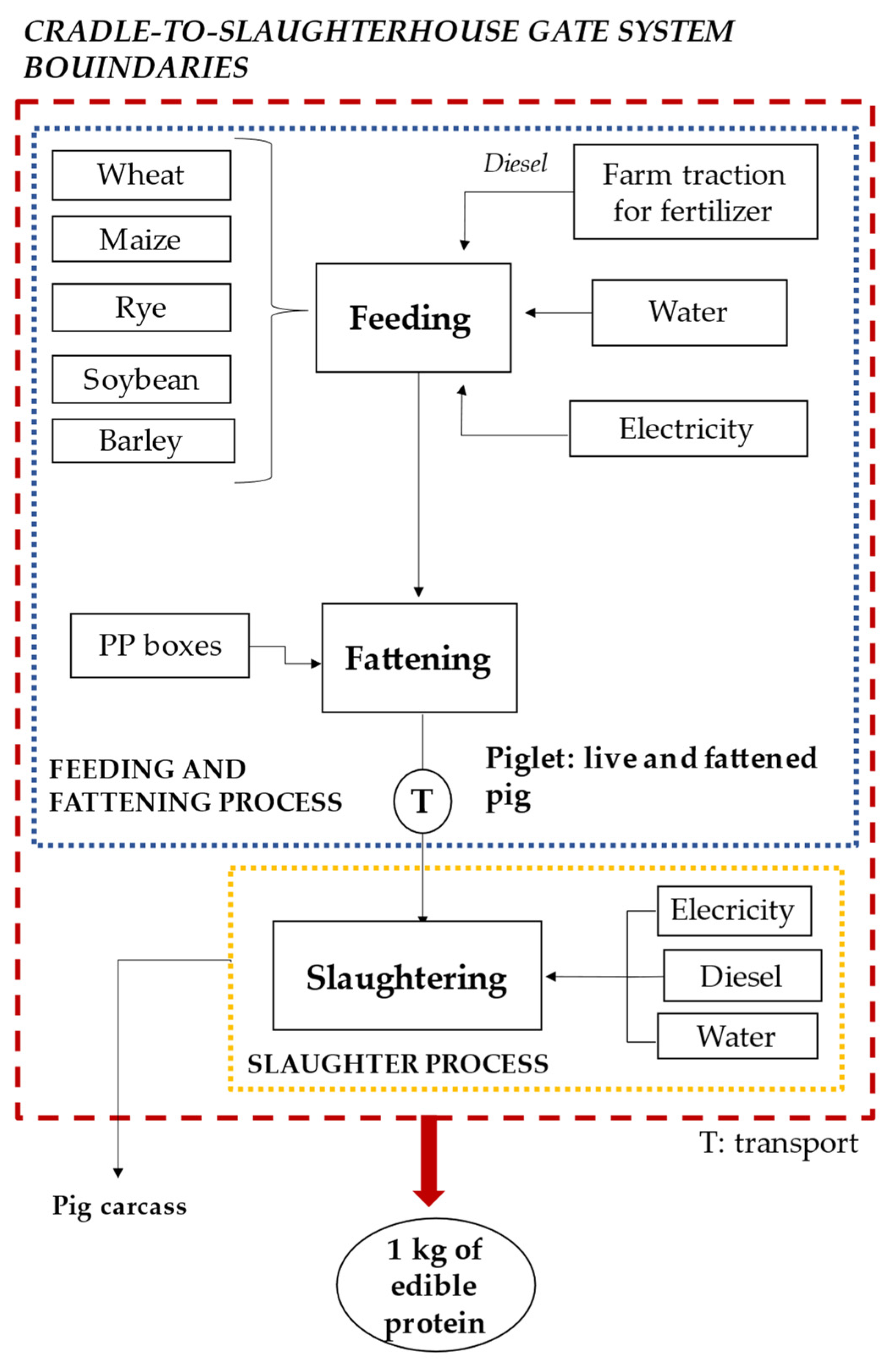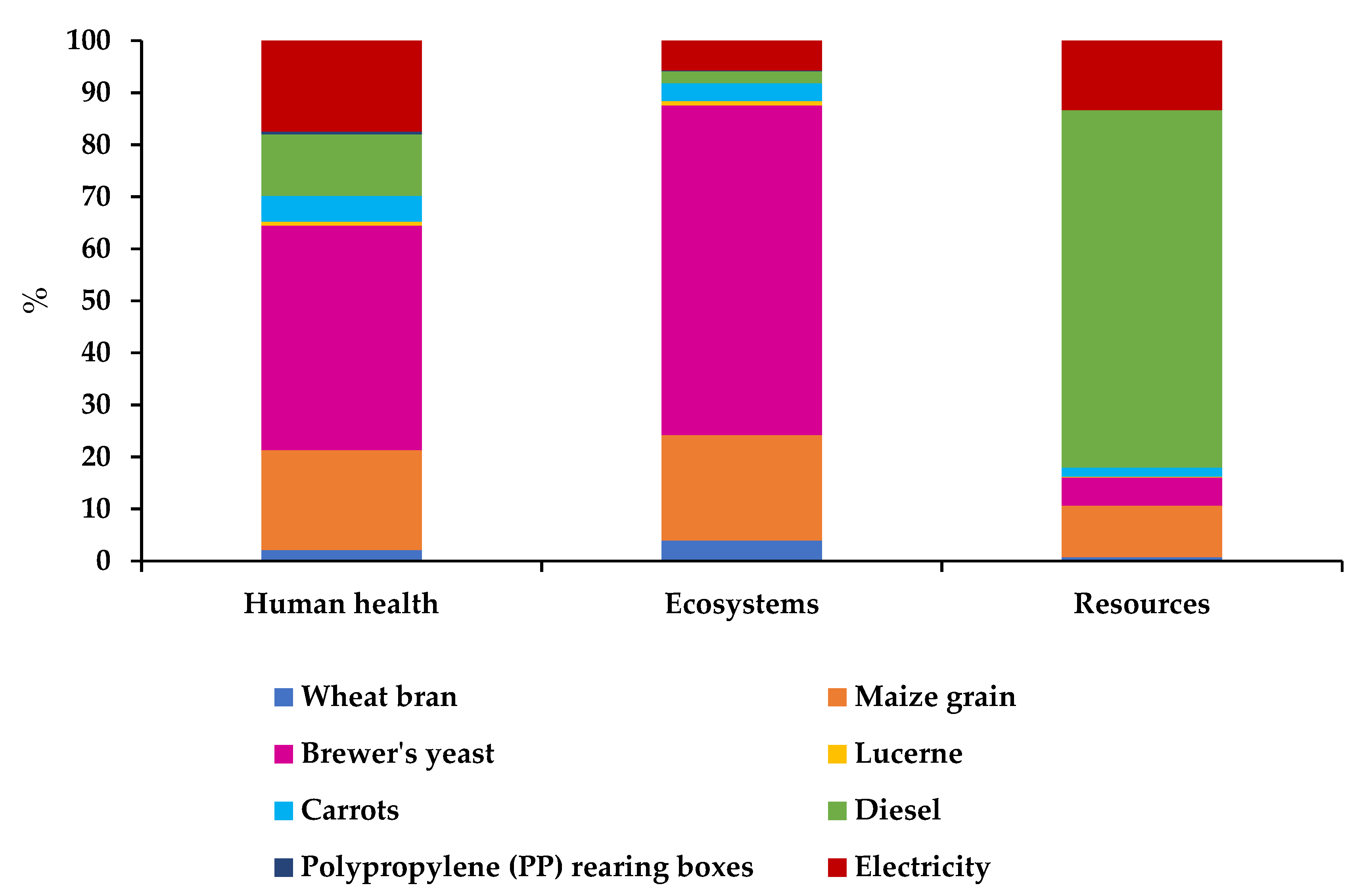The Application of Life Cycle Assessment to Evaluate the Environmental Impacts of Edible Insects as a Protein Source
Abstract
:1. Introduction
2. Materials and Methods
2.1. Goal and Scope Definition
2.1.1. Functional Unit (FU)
2.1.2. System Boundary Definition
2.2. Life Cycle Inventory (LCI)
2.3. Life Cycle Impact Assessment (LCIA)
3. Results and Discussion
3.1. Sustainability Assessment of INSECT (T. molitor) Production
3.1.1. Human Health
3.1.2. Ecosystem
3.1.3. Resources
3.2. Sustainability Assessment of Pork Production
3.2.1. Human Health
3.2.2. Ecosystems
3.2.3. Resources
3.3. System Production Comparison
4. Conclusions
Supplementary Materials
Author Contributions
Funding
Institutional Review Board Statement
Informed Consent Statement
Data Availability Statement
Conflicts of Interest
References
- World Health Organization. The State of Food Security and Nutrition in the World 2021: Transforming Food Systems for Food Security, Improved Nutrition and Affordable Healthy Diets for All; Food & Agriculture Org.: Rome, Italy, 2021; Volume 2021. [Google Scholar]
- Bongaarts, J.; FAO; IFAD; UNICEF; WFP; WHO. The State of Food Security and Nutrition in the World 2020: Transforming Food Systems for Affordable Healthy Diets; FAO: Rome, Italy, 2021; 320p. [Google Scholar]
- United Nations. Department of Economic and Social Affairs, Population Division. In World Population Prospects 2019; United Nations Department of Economic and Social Affairs: New York, NY, USA, 2019; Highlights (ST/ESA/SER.A/423). [Google Scholar]
- Toral, P.G.; Hervás, G.; González-Rosales, M.G.; Mendoza, A.G.; Robles-Jiménez, L.E.; Frutos, P. Insects as alternative feed for ruminants: Comparison of protein evaluation methods. J. Anim. Sci. Biotechnol. 2022, 13, 1–8. [Google Scholar] [CrossRef] [PubMed]
- Food and Agriculture Organization of the United Nations. FAOSTAT—Digital Database: Food Security Indicators. 2022. Available online: https://www.fao.org/faostat/en/#data/FS (accessed on 6 June 2022).
- Raheem, D.; Raposo, A.; Oluwole, O.B.; Nieuwland, M.; Saraiva, A.; Carrascosa, C. Entomophagy: Nutritional, ecological, safety and legislation aspects. Food Res. Int. 2019, 126, 108672. [Google Scholar] [CrossRef] [PubMed]
- Environmental Working Group; Hamerschlag, K.; Venkat, K. Meat Eaters Guide: Methodology 2011. Life Cycle Assessment: Methodology and Results. 2011. Available online: http://static.ewg.org/reports/2011/meateaters/pdf/methodology_ewg_meat_eaters_guide_to_health_and_climate_2011.pdf (accessed on 5 June 2022).
- Alexander, P.; Brown, C.; Arneth, A.; Dias, C.; Finnigan, J.; Moran, D.; Rounsevell, M.D.A. Could consumption of insects, cultured meat or imitation meat reduce global agricultural land use? Glob. Food Secur. 2017, 15, 22–32. [Google Scholar] [CrossRef]
- Food and Agriculture Organization of the United Nations. Meat Market Review: Emerging Trends and Outlook; FAO: Rome, Italy, 2021. [Google Scholar]
- Raubenheimer, D.; Rothman, J.M. Nutritional ecology of entomophagy in humans and other primates. Annu. Rev. Entomol. 2013, 58, 141–160. [Google Scholar] [CrossRef] [Green Version]
- Van Huis, A.; Van Itterbeeck, J.; Klunder, H.; Mertens, E.; Halloran, A.; Muir, G.; Vantomme, P. Edible Insects: Future Prospects for Food and Feed Security; Food and agriculture organization of the United Nations: Rome, Italy, 2013; p. 17. [Google Scholar]
- Gao, Y.; Wang, D.; Xu, M.L.; Shi, S.S.; Xiong, J.F. Toxicological characteristics of edible insects in China: A historical review. Food Chem. Toxicol. 2018, 119, 237–251. [Google Scholar] [CrossRef]
- Yi, C.H.; He, Q.J.; Lin, W.; Kuang, R.P. The utilization of insect- resources in Chinese rural area. J. Agric. Sci. 2010, 2, 146–154. [Google Scholar] [CrossRef]
- Statista. Edible Insects—Statistics and Facts. 2019. Available online: https://www.statista.com/topics/4806/edible-insects/ (accessed on 4 June 2022).
- Finke, M.D.; DeFoliart, G.R.; Benevenga, N.J. Use of a four-parameter logistic model to evaluate the quality of the protein from three insect species when fed to rats. J. Nutr. 1989, 119, 864–871. [Google Scholar] [CrossRef] [Green Version]
- Probst, L.; Frideres, L.; Pedersen, B.; Amato, F.; Luxembourg, P. Sustainable Safe, and Nutritious Food: New Nutrient Sources. Bruss. Belg. Eur. Comm. 2015, 53, 1–18. [Google Scholar]
- Nowak, V.; Persijn, D.; Rittenschober, D.; Charrondiere, U.R. Review of food composition data for edible insects. Food Chem. 2016, 193, 39–46. [Google Scholar] [CrossRef]
- Sirimungkararat, S.; Saksirirat, W.; Nopparat, T.; Natongkham, A. Edible products from eri and mulberry silkworms in Thailand. For. Insects Food Hum. Bite Back 2010, 189, 189–200. [Google Scholar]
- Lange, K.W.; Nakamura, Y. Edible insects as a source of food bioactives and their potential health effects. J. Food Bioact. 2021, 14, 4–9. [Google Scholar] [CrossRef]
- Rumpold, B.A.; Schlüter, O.K. Potential and challenges of insects as an innovative source for food and feed production. Innov. Food Sci. Emerg. Technol. 2013, 17, 1–11. [Google Scholar] [CrossRef]
- Kim, T.K.; Yong, H.I.; Kim, Y.B.; Kim, H.W.; Choi, Y.S. Edible insects as a protein source: A review of public perception, processing technology, and research trends. Food Sci. Anim. Resour. 2019, 39, 521–540. [Google Scholar] [CrossRef] [PubMed] [Green Version]
- FAOSTAT Several Statistics. Available online: https://www.fao.org/faostat/en/#data/FS (accessed on 7 July 2022).
- International Organization For Standardization 14040. Environmental Management: Life Cycle Assessment; Principles and Framework; ISO: Geneva, Switzerland, 2006. [Google Scholar]
- International Organization For Standardization 14044. Environmental Management—Life Cycle Assessment—Requirements and Guidelines; ISO: Geneva, Switzerland, 2006. [Google Scholar]
- Dreyer, M.; Hörtenhuber, S.; Zollitsch, W.; Jäger, H.; Schaden, L.M.; Gronauer, A.; Kral, I. Environmental life cycle assessment of yellow mealworm (Tenebrio molitor) production for human consumption in Austria—A comparison of mealworm and broiler as protein source. Int. J. Life Cycle Assess. 2021, 26, 2232–2247. [Google Scholar] [CrossRef]
- Pazmiño, M.L.; Ramirez, A.D. Life cycle assessment as a methodological framework for the evaluation of the environmental sustainability of pig and pork production in Ecuador. Sustainability 2021, 13, 11693. [Google Scholar] [CrossRef]
- Reckmann, K.; Traulsen, I.; Krieter, J. Life Cycle Assessment of pork production: A data inventory for the case of Germany. Livest. Sci. 2013, 157, 586–596. [Google Scholar] [CrossRef]
- Miglietta, P.P.; de Leo, F.; Ruberti, M.; Massari, S. Mealworms for food: A water footprint perspective. Water 2015, 7, 6190–6203. [Google Scholar] [CrossRef]
- Barker, D.; Fitzpatrick, M.P.; Dierenfeld, E.S. Nutrient composition of selected whole invertebrates. Zoo Biol. 1998, 17, 123–134. [Google Scholar] [CrossRef]
- Flachowsky, G.; Meyer, U.; Südekum, K.H. Land use for edible protein of animal origin—A review. Animals 2017, 7, 25. [Google Scholar] [CrossRef]
- Dreier, C. Untersuchung zu den Schlachtschweinetransporten aus dem Raum Norddeutschland in den Jahren 2005 bis 2011; Institute of Animal Breeding and Husbandry, Chritian-Albrechts University Kiel: Kiel, Germany, 2012. [Google Scholar]
- Cortesi, A.; Pénicaud, C.; Saint-Eve, A.; Soler, L.G.; Souchon, I. Life cycle inventory and assessment data for quantifying the environmental impacts of a wide range of food products belonging to the same food category: A case study of 80 pizzas representatives of the French retail market. Data Brief 2022, 41, 107950. [Google Scholar] [CrossRef]
- Dalgaard, T.; Halberg, N.; Porter, J.R. A model for fossil energy use in Danish agriculture used to compare organic and conventional farming. Agric. Ecosyst. Environ. 2001, 87, 51–65. [Google Scholar] [CrossRef] [Green Version]
- Vinci, G.; Rapa, M. Hydroponic cultivation: Life cycle assessment of substrate choice. Br. Food J. 2019, 121, 1801–1812. [Google Scholar] [CrossRef]
- Smetana, S.; Spykman, R.; Heinz, V. Environmental aspects of insect mass production. J. Insects Food Feed. 2021, 7, 533–571. [Google Scholar] [CrossRef]
- Offenberg, J. Oecophylla smaragdina food conversion efficiency:prospects for ant farming. J. Appl. Entomol. 2011, 135, 575–581. [Google Scholar] [CrossRef]
- Winkler, T.; Schopf, K.; Aschemann, R.; Winiwarter, W. From farm to fork–A life cycle assessment of fresh Austrian pork. J. Clean. Prod. 2016, 116, 80–89. [Google Scholar] [CrossRef] [Green Version]
- González-García, S.; Belo, S.; Dias, A.C.; Rodrigues, J.V.; da Costa, R.R.; Ferreira, A.; de Andrade, L.P.; Arroja, L. Life cycle assessment of pigmeat production: Portuguese case study and proposal of improvement options. J. Clean. Prod. 2015, 100, 126–139. [Google Scholar] [CrossRef]
- Smetana, S.; Mathys, A.; Knoch, A.; Heinz, V. Meat alternatives: Life cycle assessment of most known meat substitutes. Int. J. Life Cycle Assess. 2015, 20, 1254–1267. [Google Scholar] [CrossRef]
- Halloran, A.; Hanboonsong, Y.; Roos, N.; Bruun, S. Life cycle assessment of cricket farming in north-eastern Thailand. J. Clean. Prod. 2017, 156, 83–94. [Google Scholar] [CrossRef]
- Oonincx, D.G.A.B.; De Boer, I.J.M. Environmental Impact of the Production of Mealworms as a Protein Source for Humans - A Life Cycle Assessment. PLoS ONE 2012, 7, e51145. [Google Scholar] [CrossRef] [Green Version]





| Input | Unit | Quantity | Data Sources | |
|---|---|---|---|---|
| Feeding | Wheat bran | Kg | 18.43 | Data from [25] |
| Maize grain | Kg | 14.33 | ||
| Brewer’s yeast | Kg | 2.63 | ||
| Lucerne | Kg | 2.11 | ||
| Carrots | Kg | 20.28 | ||
| Diesel | Kg | 9.91 | ||
| On-farm feed processing | MJ | 0.32 | ||
| Rearing | Land for rearing facilities | m2 | 0.15 | |
| Polypropylene (PP) rearing boxes | Kg | 0.23 | ||
| Electric heater | MJ | 75.67 | ||
| Humidifier | MJ | 0.67 | ||
| Killing and storage | Freezing | MJ | 1.60 | |
| Blanching | MJ | 12.03 | ||
| Output | Unit | Quantity | ||
| Killed and stored mealworms | Kg | 7.30 | ||
| Input | Unit | Quantity | Data Sources | |
|---|---|---|---|---|
| Feeding and Fattening | Barley | Kg | 4.86 | Own calculations based on [27] |
| Wheat | Kg | 12.04 | ||
| Rye | Kg | 1.78 | ||
| Soybean | Kg | 2.1 | ||
| Maize | Kg | 7.16 | [26] | |
| Farm traction for fertilizer (diesel) | Kg | 70.27 | [33] | |
| Water (tap) | L | 3900 | Own calculations based on [27] | |
| Land use for rearing facilities | m2 | 5.73 | ||
| Electricity | kWh−1 | 247.8 | ||
| Slaughtering | Piglet (One fattening pig) | Kg | 120 | |
| Electricity for machinery | kWh−1 | 2.47 | ||
| Diesel | Kg | 0.8 | ||
| Water (tap) | L | 36 | ||
| Output | Unit | Quantity | ||
| Slaughtered and preserved pork | Kg | 11.05 | ||
| Impact Category | Unit | Feeding | Rearing | Killing and Storage |
|---|---|---|---|---|
| HUMAN HEALTH | ||||
| Global warming | DALYs | 2.58 × 10−5 | 9.11 × 10−6 | 1.51 × 10−6 |
| Human carcinogenic toxicity | DALYs | 1.89 × 10−6 | 1.52 × 10−6 | 2.71 × 10−7 |
| Human non-carcinogenic toxicity | DALYs | 6.98 × 10−6 | 1.62 × 10−6 | 2.90 × 10−7 |
| Stratospheric ozone depletion | DALYs | 1.45 × 10−7 | 3.72 × 10−9 | 6.64 × 10−10 |
| Ionizing radiation | DALYs | 3.44 × 10−8 | 8.48 × 10−9 | 1.51 × 10−9 |
| Ozone formation | DALYs | 6.05 × 10−8 | 1.50 × 10−8 | 2.67 × 10−9 |
| Water consumption | DALYs | 3.12 × 10−5 | 3.24 × 10−7 | 5.78 × 10−8 |
| Fine particulate matter formation | DALYs | 3.73 × 10−5 | 6.18 × 10−6 | 1.10 × 10−6 |
| ECOSYSTEMS | ||||
| Global warming. Terrestrial ecosystems | species.yr | 7.79 × 10−8 | 2.75 × 10−8 | 4.56 × 10−9 |
| Global warming. Freshwater ecosystems | species.yr | 2.13 × 10−12 | 7.51 × 10−13 | 1.25 × 10−13 |
| Ozone formation. Terrestrial ecosystems | species.yr | 2.15 × 10−9 | 8.81 × 10−9 | 3.85 × 10−10 |
| Terrestrial acidification | species.yr | 6.06 × 10−9 | 6.72 × 10−8 | 1.08 × 10−9 |
| Freshwater eutrophication | species.yr | 1.16 × 10−8 | 1.81 × 10−9 | 3.23 × 10−10 |
| Marine eutrophication | species.yr | 1.02 × 10−10 | 4.32 × 10−13 | 7.71 × 10−14 |
| Terrestrial ecotoxicity | species.yr | 5.57 × 10−10 | 1.25 × 10−10 | 2.24 × 10−11 |
| Freshwater ecotoxicity | species.yr | 1.38 × 10−9 | 5.56 × 10−10 | 9.93 × 10−11 |
| Marine ecotoxicity | species.yr | 1.06 × 10−10 | 1.05 × 10−10 | 1.87 × 10−11 |
| Water consumption. Terrestrial ecosystem | species.yr | 5.16 × 10−7 | 1.22 × 10−9 | 2.18 × 10−10 |
| Water consumption. Aquatic ecosystems | species.yr | 3.86 × 10−11 | 7.37 × 10−14 | 1.32 × 10−14 |
| Land use | species.yr | 4.02×10−7 | 1.80 × 10−8 | 3.21 × 10−9 |
| RESOURCES | ||||
| Mineral resource scarcity | USD2013 | 5.62 × 10−2 | 3.95 × 10−3 | 7.06 × 10−4 |
| Fossil resource scarcity | USD2013 | 6.63 | 8.49 × 10−1 | 1.52 × 10−1 |
| Impact Category | Unit | Feeding and Fattening | Slaughter Process |
|---|---|---|---|
| HUMAN HEALTH | |||
| Global warming | DALYs | 1.41 × 10−4 | 4.23 × 10−4 |
| Stratospheric ozone depletion | DALYs | 1.75 × 10−7 | 1.23 × 10−6 |
| Ionizing radiation | DALYs | 1.25 × 10−7 | 1.12 × 10−7 |
| Ozone formation | DALYs | 3.39 × 10−7 | 4.95 × 10−7 |
| Fine particulate matter formation | DALYs | 1.53 × 10−4 | 4.90 × 10−4 |
| Human carcinogenic toxicity | DALYs | 3.14 × 10−5 | 1.48 × 10−5 |
| Human non-carcinogenic toxicity | DALYs | 4.51 × 10−5 | 2.72 × 10−5 |
| Water consumption | DALYs | 1.31 × 10−5 | 4.17 × 10−5 |
| ECOSYSTEM | |||
| Global warming. Terrestrial ecosystems | species.yr | 1.27 × 10−6 | 4.27 × 10−7 |
| Global warming. Freshwater ecosystems | species.yr | 3.48 × 10−11 | 1.16 × 10−11 |
| Ozone formation. Terrestrial ecosystems | species.yr | 4.97 × 10−8 | 7.37 × 10−8 |
| Terrestrial acidification | species.yr | 1.68 × 10−7 | 8.41 × 10−7 |
| Freshwater eutrophication | species.yr | 2.78 × 10−8 | 4.60 × 10−8 |
| Marine eutrophication | species.yr | 1.01 × 10−10 | 9.07 × 10−10 |
| Terrestrial ecotoxicity | species.yr | 3.01 × 10−9 | 6.42 × 10−9 |
| Freshwater ecotoxicity | species.yr | 7.41 × 10−9 | 5.80 × 10−9 |
| Marine ecotoxicity | species.yr | 1.34 × 10−9 | 6.35 × 10−10 |
| Land use | species.yr | 4.63 × 10−7 | 4.39 × 10−6 |
| Water consumption. Terrestrial ecosystem | species.yr | 7.08 × 10−8 | 1.11 × 10−7 |
| Water consumption. Aquatic ecosystems | species.yr | 5.25 × 10−12 | 2.33 × 10−11 |
| RESOURCES | |||
| Mineral resource scarcity | USD2013 | 9.91 × 10−2 | 3.01 × 10−1 |
| Fossil resource scarcity | USD2013 | 47.27 | 11.36 |
Publisher’s Note: MDPI stays neutral with regard to jurisdictional claims in published maps and institutional affiliations. |
© 2022 by the authors. Licensee MDPI, Basel, Switzerland. This article is an open access article distributed under the terms and conditions of the Creative Commons Attribution (CC BY) license (https://creativecommons.org/licenses/by/4.0/).
Share and Cite
Vinci, G.; Prencipe, S.A.; Masiello, L.; Zaki, M.G. The Application of Life Cycle Assessment to Evaluate the Environmental Impacts of Edible Insects as a Protein Source. Earth 2022, 3, 925-938. https://doi.org/10.3390/earth3030054
Vinci G, Prencipe SA, Masiello L, Zaki MG. The Application of Life Cycle Assessment to Evaluate the Environmental Impacts of Edible Insects as a Protein Source. Earth. 2022; 3(3):925-938. https://doi.org/10.3390/earth3030054
Chicago/Turabian StyleVinci, Giuliana, Sabrina Antonia Prencipe, Luca Masiello, and Mary Giò Zaki. 2022. "The Application of Life Cycle Assessment to Evaluate the Environmental Impacts of Edible Insects as a Protein Source" Earth 3, no. 3: 925-938. https://doi.org/10.3390/earth3030054






